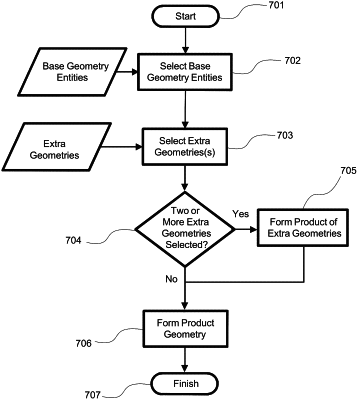| CPC G06F 30/23 (2020.01) | 20 Claims |

|
1. A computer-implemented simulation method executable on one or more processors configured to add and define one or more perfectly matched layers (PMLs) onto a model of a physical system including corners and/or curves, the model describing a wave-related phenomenon represented as a combined set of equations, the simulation method comprising the acts of:
defining, via the one or more processors, discretized geometry data of the model of the physical system as a two-dimensional mesh representation of a two-dimensional physical domain or a three-dimensional mesh representation of a three-dimensional physical domain;
receiving, via a graphical user interface, a selection of a boundary or a boundary segment corresponding to at least a portion of a boundary of the discretized geometry data, the selection representing discretized base geometry data that includes at least one corner or curved segment;
defining, via the one or more processors, discretized extra geometry data representing a meshed line segment;
in response to defining the extra geometry data and the discretized base geometry data, attaching the discretized extra geometry data to the discretized base geometry data;
defining, via the one or more processors, physics settings for modeling the physical system;
receiving PML settings inputs including coordinate stretching settings;
in response to receiving the PML settings inputs, forming, via the one or more processors, weak form expressions representing the wave-related phenomenon of the model, the weak form expressions including weak form PML expressions based on the received PML settings and one or more of the physics settings parametrized using modified geometry data including the discretized base geometry data associated with the boundary selection or the boundary segment selection, the attached discretized extra geometry data, and at least a portion of the PML settings inputs, wherein one of (i) base geometry mesh elements and extra geometry mesh elements are one-dimensional for a two-dimensional physical domain model, or (ii) base geometry mesh elements are two-dimensional and extra geometry elements are one-dimensional, respectively, for a three-dimensional physical domain model, at least one of the base geometry and extra geometry mesh elements optionally being curved; and
simulating, via the one of more processors, the wave-related phenomena of the model based on the weak form expressions, the simulating acts including:
generating matrix data representing an assembling of a stiffness and/or dampening matrix based on the formed weak form expressions;
generating solution data representing a solution to the wave-related phenomenon of the model; and
generating a graphical representation of at least a portion of the solution data, the graphical representation configured for display on a graphical user interface.
|